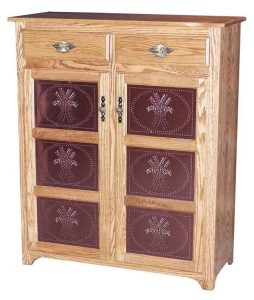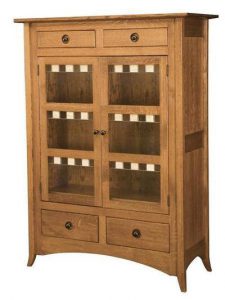
History of the Pie Safe
For a good part of the 19th century, a very important piece of furniture sat in the middle of many kitchens — the pie safe. Also known as a pie cabinet, pie cupboard, pie chest, or kitchen safe, the pie safe helped to keep pesky insects, rodents, and dirt away from freshly baked goods.
Origins
It is believed that the pie safe was first introduced in the United States in the 1800s by German immigrants who would come to be known as the Pennsylvania Dutch.
Word spread quickly about the new storage solution that protected baked goods. The pie safe became the closest thing to a refrigerator, making it a popular and relied upon piece of kitchen furniture. Ventilation, in the form of screens or tin with holes punched into it, contributed to keeping baked goods cool and preventing mold growth. The pie safe’s appeal started to wane at the end of the 19th century when the icebox entered the picture.
Construction
Original pie safes were the size of large bureaus and were made from solid wood. Yellow pine was the most common wood choice. Soft pine was often used to make the shelves and drawers. Variations in size and shape contributed to its appeal. Most were freestanding cabinets with deep shelves. Pie safes with tin doors were the most common. Designs were created by the punched holes that also provided ventilation. Church scenes and simple shapes were the most popular.
Pie Safe Styles
Freestanding
A solid wood cabinet standing on four legs was the most common design. The Amish Shaker Hill Cabinet is a solid wood, freestanding style.
Tin Panel Feature
Punched tin panel designs such as those on the Amish Lancaster Raised Panel Pie Safe with Tin Doors added decoration while providing much needed ventilation.
Glass Doors
The Amish Modesto Two Door Cabinet offers the option of glass or copper doors, adding an upscale and elegant appearance.
Copper Accents
The copper wheat panel designs on the doors of the Traditional Pie Safe Cabinet contribute easily to a country style furniture collection.

Pie Safes Today
The pie safe has become a treasured antique, with its versatile style providing a variety of storage options. Today, it easily contributes to the popular shabby chic look. Not just for pies anymore, solid wood safes are perfect for the kitchen, pantry, hallway, or mudroom.
Our Amish made pie safes are customizable replicas of some of the original designs brought to the United States by the Pennsylvania Dutch, and can be used for anything from crafting supplies to baked goods.









We have my grandmother’s all tin enclosed pie safe—her name and the date 1884 appear on the front two panels: we were told an uncle made it for her upon her birth Definately PA Dutch Lehigh County PA.
Any suggestions on a quality repair / restore craftsmen?
Hi Ray,
Thank you for your question. One of our support specialists recommended U.S. Quality Furniture Repair. We also recommend doing a search on Yelp or general search for “furniture repair specialist” or “furniture restoration specialist” in or near your area. That way you can read reviews before deciding who to contact for repair and restoration.
Ray:
I am writing a book on pie safes.
Can we talk about the one you mentioned?
Dennis
I have my family’s Pie Safe that I bought from my dad years ago after the farm sold. It’s always been in my family. It has screens in the sides and front doors. In the back of the pie safe, it has written Mendon, MI and the number, it looks like 32 or 82(?) This is written looks like in Black paint when it was made. I was wondering, were the pie safes made with screens older then the tin one’s? The screens have a very faded design on the screens. Not sure if the 32 or 82 was a date made or a stock number? But it always been it my family. I just love it. And my dad’s side of family came from Prussia
Hi Suann,
Your pie safe sounds beautiful. I haven’t been able to determine if screens or punched tin were used first in pie safe designs. They are both mentioned as popular for helping keep air circulating to cool baked goods, help prevent mold and keep out rodents and flies. Thank you for sharing your pie safe with us and thank you for visiting Timber to Table.